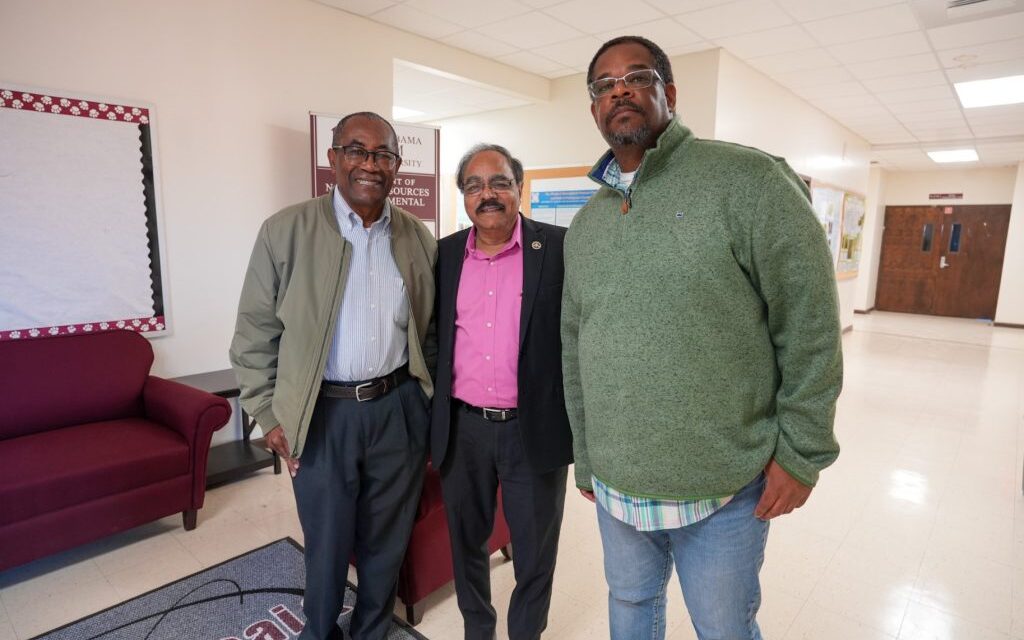Three AAMU scientists in the Department of Natural Resources and Environmental Sciences received a $1.153 million grant to teach farmers how to select crops and trees that are resistant to climate change.
The grant is part of a 5-year, $5 Million grant awarded to four 1890 Agroforestry Consortium Institutions: Tuskegee University, Alabama A&M University, University of Maryland Eastern Shore, and Virginia State University by The National Institute of Food and Agriculture – Natural Resources Conservation Service (NIFA-NRCS).
Dr. Srinivasa Rao Mentreddy, Professor of Crop Science (AAMU Campus PI), Dr. Colmore Christian, Professor, Forestry, and Dr. Dedrick Davis, Associate Professor, Soil Physics, will use the grant to promote climate-smart agroforestry alley cropping among marginal producers and landowners in Alabama.
“Climate-smart agriculture integrates adoption, adaptation and mitigation strategies for addressing climate change effects,” says Mentreddy. “In this project, we teach farmers by demonstrations, how to select crops that are adopted to combat climate change effects, mainly drought and heat stress. Crops can be adapted to stresses using cultivation practices such as selecting crops and trees that have low a carbon-foot print and sequester carbon by shedding leaves in winter, and using water effectively for fruits that fetch premium prices.”
“This project is led by Tuskegee University,” says Christian. “Alabama A&M University and University of Maryland Eastern Shore will focus on promoting Agroforestry alley cropping specialty vegetable and medicinal herbs between rows of fig and persimmon trees by providing immersive training and education to ten farmers each in Alabama and Maryland.”
Tuskegee University and Virginia State University scientists will promote silvopasture, which integrates forage grasses and forest trees with livestock on ten farms each in Alabama and Virginia.
Mentreddy will be responsible for training marginal farmers in establishing and managing alley crops and fruit trees. Davis will assess greenhouse gas emissions and carbon sequestration in the alley cropping systems, and Christian will recruit farmers and coordinate training activities with the help of extension outreach professionals. The collaborator at the University of Maryland Eastern Shore will be responsible for determining cost-benefit ratios of the system by gathering data on production costs and market value of the produce from the participating farmers in three states, Alabama, Virginia, and Maryland.
“In this project we will promote fig and persimmon trees that have low carbon foot print and sequester carbon and their fruits fetch premium prices in the market,” says Mentreddy. “Alley crops such as Indian eggplants, mariachi and colored peppers, pumpkins, ginger, and turmeric are drought tolerant and also fetch high prices for farmers.”
“These add carbon to the soil at the end of the season,” says Davis. “This system of growing fruit trees and high value vegetable and medicinal herbs will generate a steady stream of income throughout the year, improve farmer’s economic status and ensure sustainability overall in the face of climate change effects.”
The AAMU scientists say the process of selecting farmers has now begun and the alley cropping systems will be established on farms in early spring or summer of 2024.
“This project will support small-scale and other underserved producers and farmers in Alabama, Maryland and Virginia, with financial and technical assistance to transform their traditional production into a multi-pronged agroforestry-based climate-smart, sustainable production system,” say Drs. Mentreddy and Christian.
“Partners will form a marketing network for labelling, packaging, and branding CS commodities,” adds Davis. One AAMU graduate student will also receive full assistantship to pursue a Ph.D. in Plant and Soil Science.”










